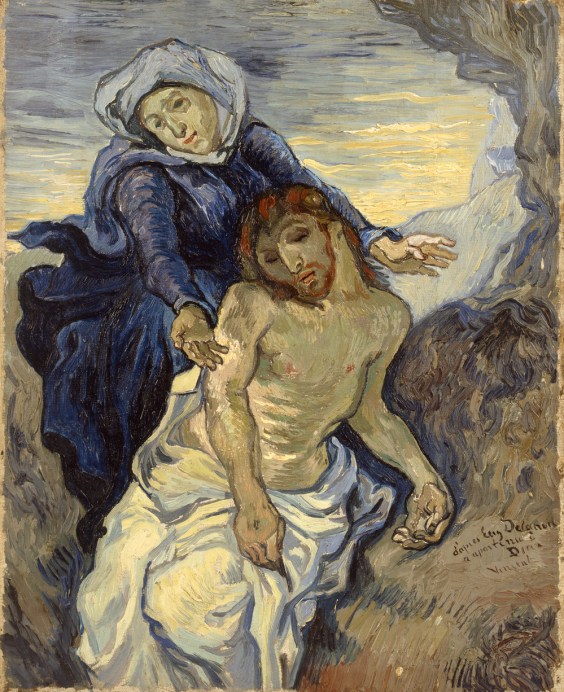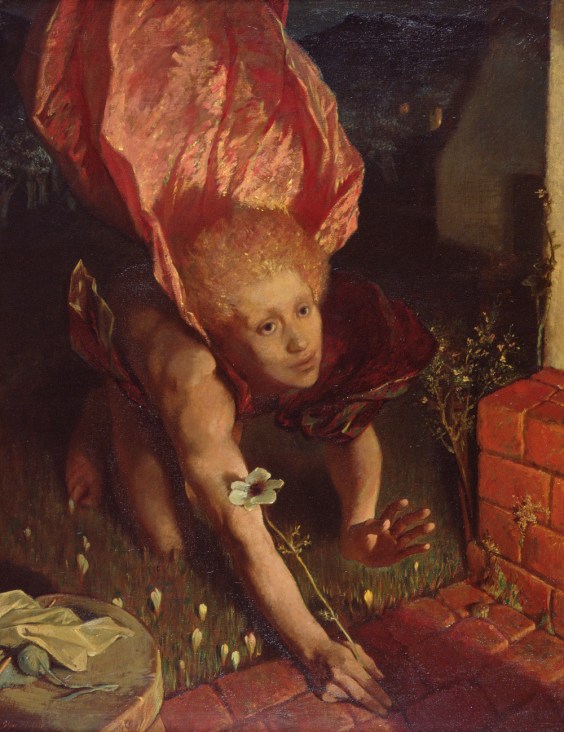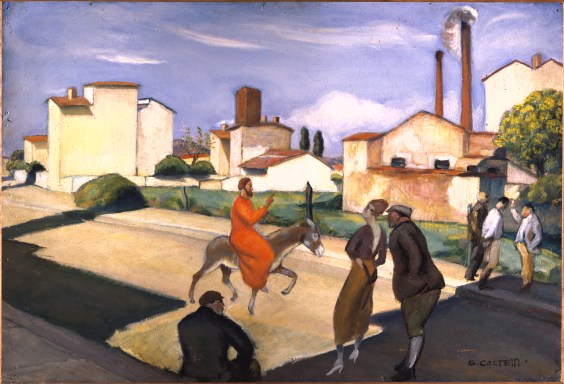Preview from the November 2015 issue of Apollo: subscribe here
Sometimes an exhibition reels you in when you least expect it. I didn’t anticipate much from ‘Divine Beauty from Van Gogh to Chagall and Fontana’ (until 24 January 2016) at Palazzo Strozzi, partly because the show has been so heavily marketed around Florence with one of its more crowd-pleasing images – Van Gogh’s Pietà (after Delacroix) – and partly in view of its title, which takes such a brazen three-dart approach to scoring a blockbuster. But this was short-sighted. For in its beautifully hung galleries, this exhibition presents a complex and engaging vision of modern sacred art, rich with spiritual idiosyncrasies and art-historical surprises.
The received history of 20th-century art privileges secularism over spirituality, even when – as in the case of Bacon’s Three Studies for Figures at the Base of a Crucifixion – it prizes works that enlist religious representational traditions as they explore the modern condition. But ‘Divine Beauty’ emphasises other attitudes, at the levels of both personal belief and institutional involvement. And in its intensity it makes a convincing claim for sacred art not, as might be supposed, as a nostalgic individual plea against the disenchantment of the world, but as an abundant and central theme for modern art.

The Pietà (after Delacroix) (c. 1890), Vincent van Gogh. Vatican City, Musei Vaticani, Collezione d’Arte Contemporanea. Photo © Governatorato dello Stato della Città del Vaticano- Direzione dei Musei
Here is a room dedicated to Mary as Rosa Mystica at the fin de siècle, followed by a cluster of Annunciations in which the need to reinvest the Gospel narrative with wonder took on an profound compositional charge for a wide range of artists: for Glyn Warren Philpot, this meant an almost supplicant archangel viewed front on, as if dramatically infusing the world beyond the painting with grace; for Libero Andreotti, it entailed a return to a late-medieval sculptural idiom, the elongated bronze figures of the Virgin and angel suggesting a persistence of belief through a reversion of style.

The Angel of the Annunciation (1925), Glyn Warren Philpot
Although the scope here is European, the exhibition is dominated by art in the Catholic tradition, and it explores both the deep-seated hold of religion on the life of Italy and the direct influence of the modern Church on the lives of Italian artists. Giovanni Costetti’s Christ’s Entry into Jerusalem presents a vision in which the Saviour rides into an industrial suburb of Florence, its indifferent bystanders gesturing towards a society in which belief may be quotidian but in which its endurance is far from guaranteed. The display also includes numerous ecclesiastical or religious commissions, including works from Lucio Fontana’s ‘white’ Via Crucis series, with their glazed terracotta smeared towards an abstract violence. A small room dedicated to Gino Severini’s designs for churches in Switzerland makes for an illuminating exhibition-within-an-exhibition.

Christ’s Entry into Jerusalem (c. 1923–26), Giovanni Costetti Courtesy Palazzo Strozzi, Florence
Aside from the specific historical interest here, the exhibition is a salutary reminder to those of us with a secular mindset of the need to appreciate faith in its many manifestations when thinking about 20th-century art. Indeed, the display put me in mind of that bravura passage in Michael Baxandall’s Painting and Experience in Fifteenth-century Italy, in which the art historian sets out the gradations of the Virgin’s gestures in Renaissance Annunciations, directing us to the relevance of historical doctrinal nuance for our understanding of such works. In this context, the Strozzi show feels like a cue to recover the intellectual, emotional and political circumstances of modern sacred art.
The spiritual persists in art today, of course, even if it has been marginalised more than ever by the fetishised everyday of contemporary art. Published this month is Aaron Rosen’s Art + Religion in the 21st Century (Thames & Hudson), a timely introduction to art that engages with spirituality today, and a corrective to the notion of ‘contemporary artists as godless marauders on a quest to offend’. The book includes, on a spectrum reaching from sincere faith to provocative irony, artists as diverse as Gerhard Richter and Chris Ofili. Long may artists continue to express the experience of faith, and scrutinise the evidence of doubt.
Click here to buy the latest issue of Apollo

Editor’s Letter: Spirituality in Modern Art
Madonna II (1895–1902), Edvard Munch. Private collection Ars Longa, Vita Brevis/Tor Petter Mygland, Oslo.
Share
Preview from the November 2015 issue of Apollo: subscribe here
Sometimes an exhibition reels you in when you least expect it. I didn’t anticipate much from ‘Divine Beauty from Van Gogh to Chagall and Fontana’ (until 24 January 2016) at Palazzo Strozzi, partly because the show has been so heavily marketed around Florence with one of its more crowd-pleasing images – Van Gogh’s Pietà (after Delacroix) – and partly in view of its title, which takes such a brazen three-dart approach to scoring a blockbuster. But this was short-sighted. For in its beautifully hung galleries, this exhibition presents a complex and engaging vision of modern sacred art, rich with spiritual idiosyncrasies and art-historical surprises.
The received history of 20th-century art privileges secularism over spirituality, even when – as in the case of Bacon’s Three Studies for Figures at the Base of a Crucifixion – it prizes works that enlist religious representational traditions as they explore the modern condition. But ‘Divine Beauty’ emphasises other attitudes, at the levels of both personal belief and institutional involvement. And in its intensity it makes a convincing claim for sacred art not, as might be supposed, as a nostalgic individual plea against the disenchantment of the world, but as an abundant and central theme for modern art.
The Pietà (after Delacroix) (c. 1890), Vincent van Gogh. Vatican City, Musei Vaticani, Collezione d’Arte Contemporanea. Photo © Governatorato dello Stato della Città del Vaticano- Direzione dei Musei
Here is a room dedicated to Mary as Rosa Mystica at the fin de siècle, followed by a cluster of Annunciations in which the need to reinvest the Gospel narrative with wonder took on an profound compositional charge for a wide range of artists: for Glyn Warren Philpot, this meant an almost supplicant archangel viewed front on, as if dramatically infusing the world beyond the painting with grace; for Libero Andreotti, it entailed a return to a late-medieval sculptural idiom, the elongated bronze figures of the Virgin and angel suggesting a persistence of belief through a reversion of style.
The Angel of the Annunciation (1925), Glyn Warren Philpot
Although the scope here is European, the exhibition is dominated by art in the Catholic tradition, and it explores both the deep-seated hold of religion on the life of Italy and the direct influence of the modern Church on the lives of Italian artists. Giovanni Costetti’s Christ’s Entry into Jerusalem presents a vision in which the Saviour rides into an industrial suburb of Florence, its indifferent bystanders gesturing towards a society in which belief may be quotidian but in which its endurance is far from guaranteed. The display also includes numerous ecclesiastical or religious commissions, including works from Lucio Fontana’s ‘white’ Via Crucis series, with their glazed terracotta smeared towards an abstract violence. A small room dedicated to Gino Severini’s designs for churches in Switzerland makes for an illuminating exhibition-within-an-exhibition.
Christ’s Entry into Jerusalem (c. 1923–26), Giovanni Costetti Courtesy Palazzo Strozzi, Florence
Aside from the specific historical interest here, the exhibition is a salutary reminder to those of us with a secular mindset of the need to appreciate faith in its many manifestations when thinking about 20th-century art. Indeed, the display put me in mind of that bravura passage in Michael Baxandall’s Painting and Experience in Fifteenth-century Italy, in which the art historian sets out the gradations of the Virgin’s gestures in Renaissance Annunciations, directing us to the relevance of historical doctrinal nuance for our understanding of such works. In this context, the Strozzi show feels like a cue to recover the intellectual, emotional and political circumstances of modern sacred art.
The spiritual persists in art today, of course, even if it has been marginalised more than ever by the fetishised everyday of contemporary art. Published this month is Aaron Rosen’s Art + Religion in the 21st Century (Thames & Hudson), a timely introduction to art that engages with spirituality today, and a corrective to the notion of ‘contemporary artists as godless marauders on a quest to offend’. The book includes, on a spectrum reaching from sincere faith to provocative irony, artists as diverse as Gerhard Richter and Chris Ofili. Long may artists continue to express the experience of faith, and scrutinise the evidence of doubt.
Click here to buy the latest issue of Apollo
Unlimited access from just $16 every 3 months
Subscribe to get unlimited and exclusive access to the top art stories, interviews and exhibition reviews.
Share
Recommended for you
Modern art is not the enemy of religious art – it’s revived it
Christian art can never be straightforwardly representational
Auckland Castle’s plan to revive religious art
Having Bill Viola open proceedings this summer is a real coup
Review: Bill Viola’s ‘Martyrs’ at St Paul’s Cathedral
‘Martyrs’ is a beautiful series of videos, but it’s overshadowed by Wren’s magnificent architecture